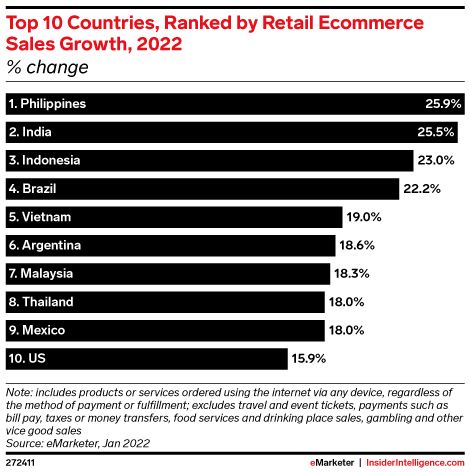Want Shopper Loyalty in Asia? You Need a Multi-Channel Approach

Did you know that the total value of eCommerce sales in Southeast Asia is expected to cross the $100 billion mark by 2023? In addition, China remains the largest eCommerce market in the world by far, with digital sales projected to reach $2 trillion by 2025. This makes Asia the fastest-growing region in the world when it comes to online sales.
In particular, Indonesia and the Philippines are expected to lead the pack with individual growth exceeding the average regional rate of 20.6%. Malaysia, Vietnam, and Thailand aren’t far behind, ranking among the world’s top ten in terms of retail eCommerce sales for 2022.

These impressive numbers are mainly driven by greater mobile penetration, growing popularity of large-scale eCommerce platforms, and permanent changes in shopping behaviour triggered by the pandemic. But, while this signals amazing growth opportunities for brands who want to expand digital sales in Asia, merchants must also keep in mind that the region’s consumers are as diverse as they come. That means that consumer engagement strategies need to take an omnichannel approach.
To win customer loyalty in Asia, brands need a multi-channel strategy
According to McKinsey & Company, Asian consumers may use non-Asian social media platforms, but they still largely prefer to follow Asian influencers, shop on Asian eCommerce platforms, and use Asian payment providers. However, these preferences vary from country to country. The state of chat apps in Asia alone shows how diverse the region’s consumer market is in terms of channel preference.
In a nutshell: having a single playbook for all markets in the region simply won’t cut it. Appealing to Asian consumers and winning their loyalty requires tailored, localised strategies that don’t neglect country-specific preferences in social media platforms, communication channels, payment methods, and more.
For eCommerce brands, this highlights the crucial importance of establishing a presence on the right channels in order to reach the right markets.
- Want to break into Korea? Make sure you’re on KakaoTalk
- To unlock Vietnamese markets, make sure you’re on Zalo
- If you’re trying to enter China without being on WeChat, you’re definitely missing out
- With a highly targeted APAC audience, Viber could be the missing piece in your engagement strategy
- Many Asian consumers still consider the availability of voice calls as key to establishing brand trust
That said, it’s simply not enough for brands to just pick the most popular channels and put all their eggs into one basket. Google found that the average APAC consumer uses as many as five different messaging apps monthly for different purposes. This means that individual customer preferences may differ, even within the same country or segment, as certain shoppers are likely to favour one or two channels over the rest.
This is why forward-thinking businesses are casting their net wide by being available on as many channels as possible, to reach as many consumers as possible.
Managing multi-channel engagement has its challenges
Asia’s shoppers are becoming increasingly digital-savvy—which puts pressure on brands to keep up. In particular, meeting the digital expectations of modern Asian consumers requires that businesses deliver consistent, coherent, and unified brand experiences across all channels, both online and offline.
For businesses, this brings many internal and operational challenges, especially if service teams are operating in informational silos and toggling between different platforms for customer engagement. The top five challenges in effective management of multi-channel environments include:
- Data integration
- Understanding consumer behaviour
- Channel evaluation
- Allocation of resources across channels
- Coordination of channel strategies
The problem, however, is that shoppers don’t see that. Regardless of a brand's internal challenges, they want to be able to switch between platforms—whether that’s SMS, chat apps, voice, or video calls—and experience the same quality of service and engagement. And, they don’t want to be kept waiting. But to achieve this, eCommerce brands need a cost-effective way to automate, streamline, and scale their multi-channel communications for more personalised, human-centric engagement.
Communication APIs: Go beyond multi-channel to achieve omnichannel
To meet customer expectations, and deliver experiences that will win Asian shopper loyalty, brands need to be everywhere, all the time, on the platforms that consumers prefer.
Enter communication APIs. These APIs allow eCommerce brands to enjoy the benefits of delivering human-centric, multi-channel engagement, without the onerous financing, technologies, and human resources needed to building in-house digital solutions from scratch.
What’s more, communication APIs allow brands to integrate various engagement channels, such as chat apps, SMS, voice, and video, directly into their native platforms, making it possible to deliver more seamless, branded customer experiences.
When combined with a unified internal dashboard like 8x8 Connect, APIs also help businesses work smarter, not harder. By consolidating all engagement channels on a single internal dashboard, businesses get greater transparency and easier management. This means that even with a small team, you’ll be able to give customers multiple options to reach you without compromising on scalability and growth.
Ready to start reaping the benefits of omnichannel engagement? Get in touch with us at hello-cpaas@8x8.com today to find out how to start using communication APIs to win shopper loyalty and expand your brand presence in Asia.
-------------------------
If you are keen to find out more about building customer loyalty with a multi-channel approach, join us at Seamless Asia, Asia’s leading virtual event dedicated to the future of payments, banking, and eCommerce. 8x8 will be attending a panel discussion:

Catch 8x8's panel discussion on-demand to gain insights to omnichannel strategies for successful retail and marketing in Asia.


